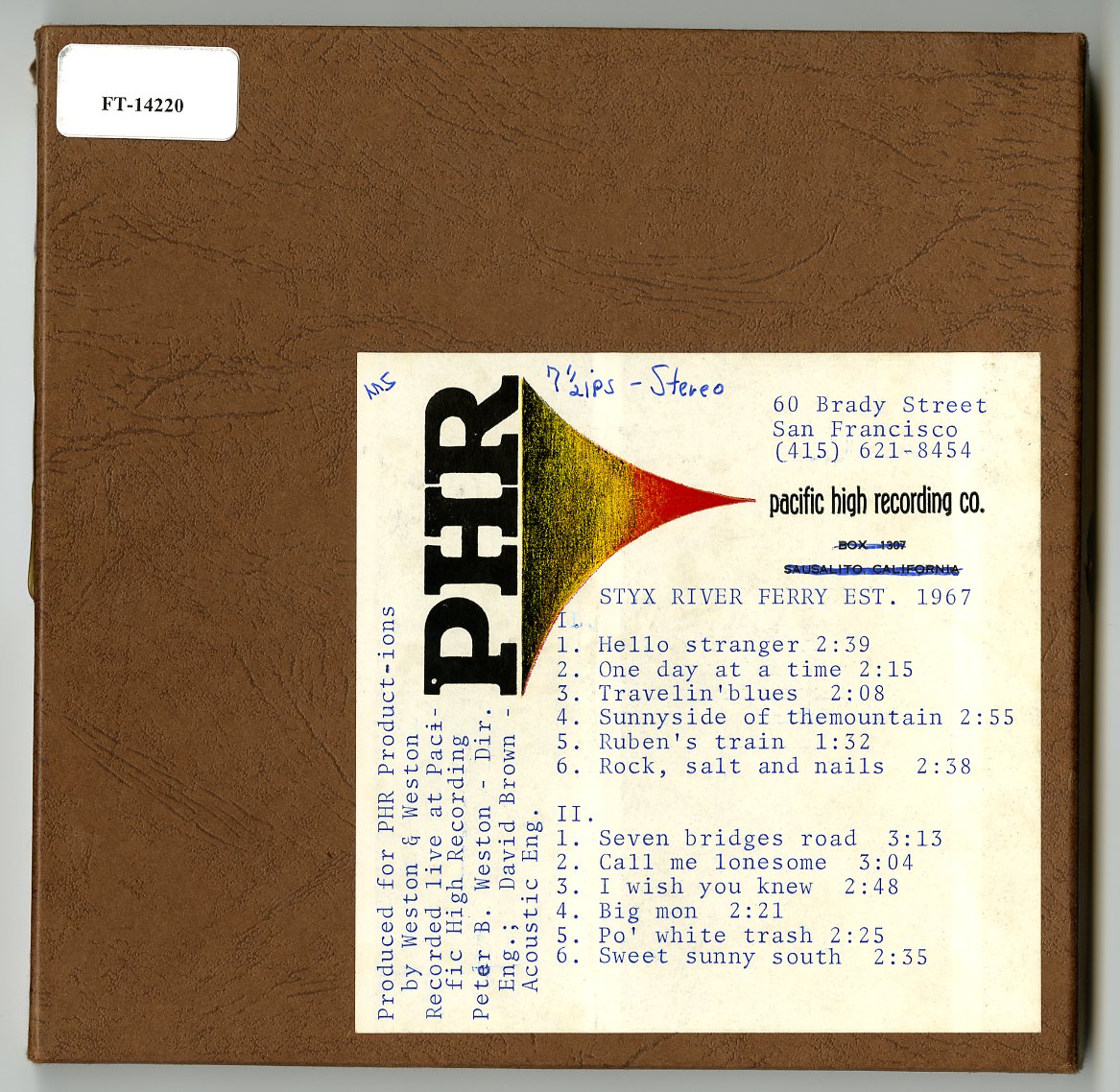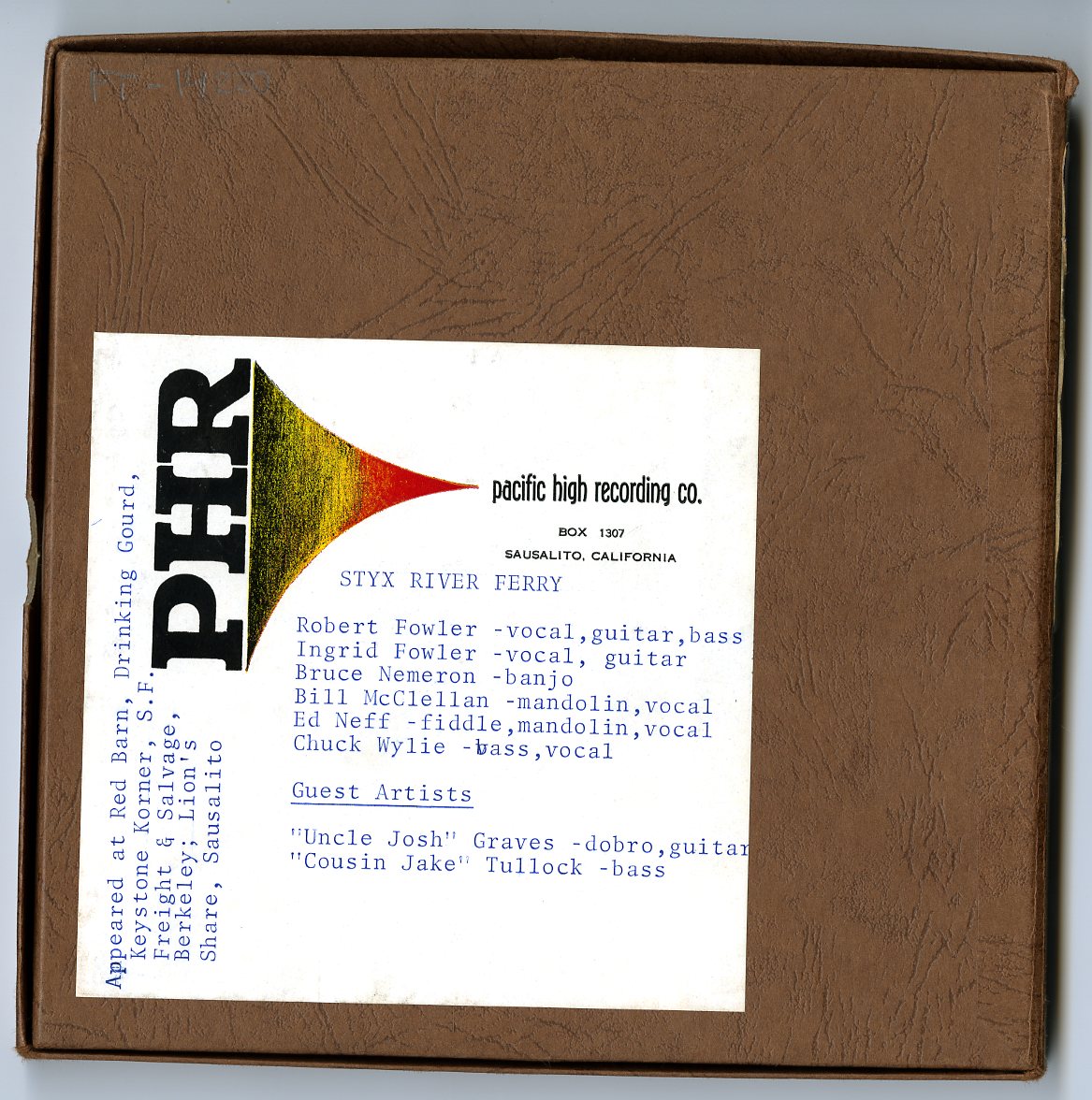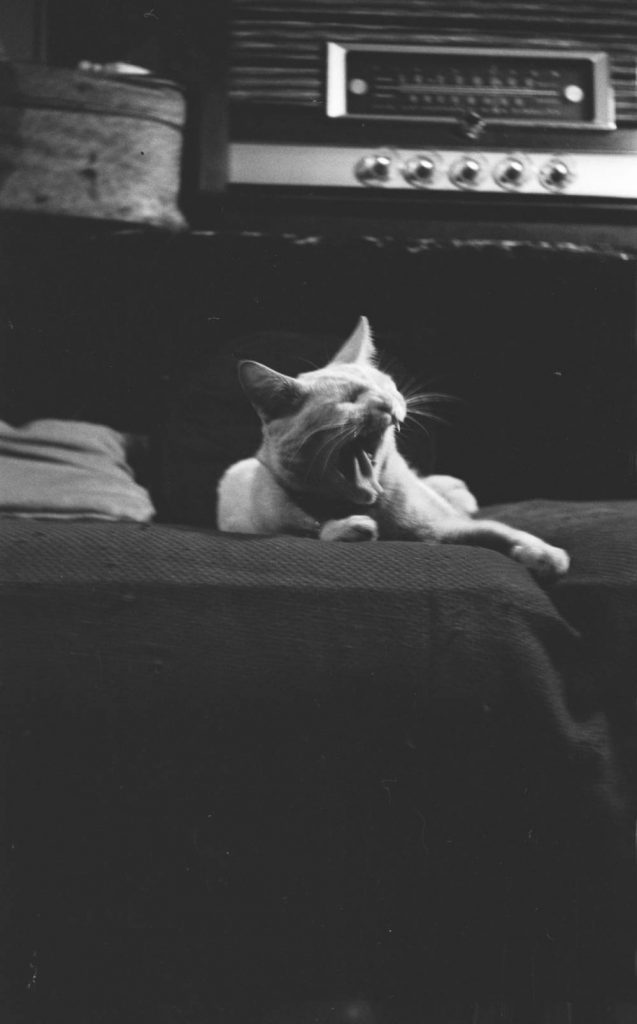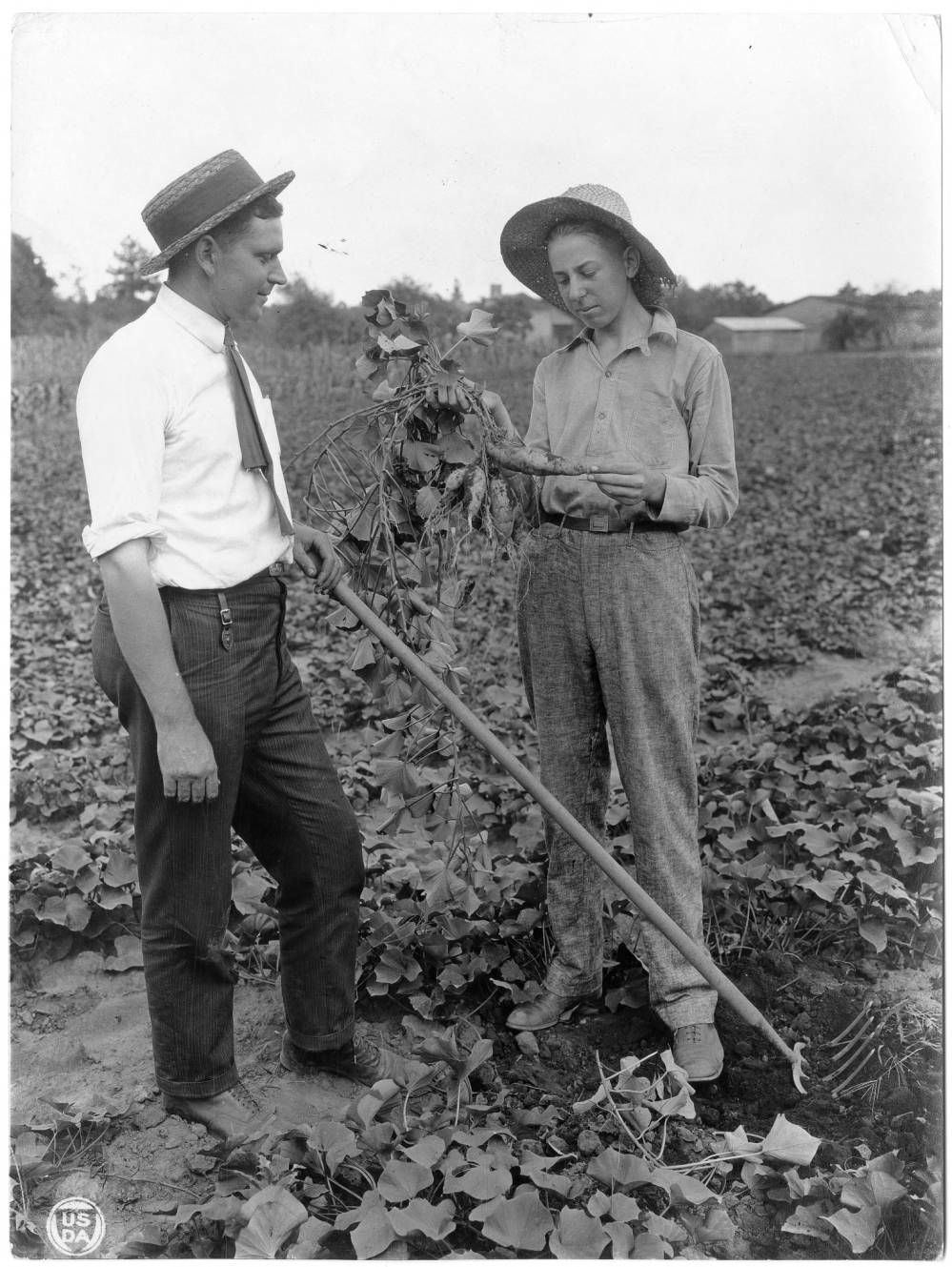During a recent cataloging session, we stumbled across this 1953 EP by composer/performer/inventor/poet/philosopher Moondog (born Louis Thomas Hardin, b.1916-d.1999), hidden in between recordings by Dizzy Dean & his Country Cousins and the Circuit Rider Quartet.
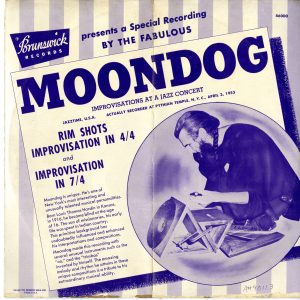
Moondog grew up in the Midwest and became blind at age 16 after playing with a dynamite cap. In the 1940s, he moved to New York City, renamed himself after an ex-pet (a dog who liked to wail at the moon), and stationed himself on a Times Square traffic median where he played his own compositions on instruments that he’d designed and built. Some time during the 1950s, increasing crowds at his performances drove him to relocate to a quieter spot near the corner of 53rd Street and 6th Avenue—and to switch from playing music to standing still for eight hours a day, sometimes reading and selling his poetry. He typically carried a spear, wore a Viking helmet, long beard, and a robe he made from pieces of army blankets. (In 1965, the New York Times reported that he’d changed to a green velvet outfit in order to avoid the “G.I. connotations” of the army blankets).
In the meantime, Moondog also recorded a number of albums for Decca, Prestige, and Columbia and gained recognition as a serious avant-garde composer. Improvisations at a Jazz Concert is the only Moondog record on the Brunswick label. It features two of his self-made, self-designed instruments—the oo (a sort of miniature dulcimer) and the trimba (two small triangular drums with a cymbal attached), as well as his characteristically elastic approach to tempo and meter that he sometimes referred to as “snake time.” Billboard magazine called the EP “one of the unusual recordings of the year” when it came out in 1953, the reviewer suggesting that “those who react to rhythm should be intrigued.”
We’ve included here an excerpt from Side 1, entitled “Improvisation in 7/4.” The EP is available at the SFC, call no. 78-16420.
Improvisation in 7/4 Excerpt

A Moondog documentary is soon to be released, the trailer for which is available here: http://thevikingof6thavenue.com/
Category: Southern Folklife Collection
Photos of the week: life according to Photo-Sound Associates
20239_pf0101_01_0002. Lee Hoffman and John Schuyler “Jock” Root at the races. Photo by Aaron Rennert, ca. 1957-1960. Photo-Sound Associates, Ron Cohen Collection (20239).
It’s hard not to get drawn into the Photo-Sound Associates images in the Ron Cohen Collection (20239). My intention is always to grab a quick photo to share on the blog and before I know it, I’ve grabbed six. I started off with the image above including the Caravan magazine founder and renaissance woman Lee Hoffman (ed. note: I recommend reading her website, Ms. Hoffman led a remarkable life) at some car races. I was looking for a different Washington Square Park photo when I saw the image below with the enormous crowd on a spring day. I can’t imagine the sound of that environment in the middle of the city. The street scenes documented by Rennert and photographer Ray Sullivan provide a fascinating look into New York City in the late 1950s. Framing musician Eric Weissberg and his Puch/Allstate 250CC two-stroke motorbike in the distance allows for a wonderful view of the architecture and 1950s automobiles. Finally, the image of Izzy Young through the window at the Folklore Center seemed the perfect way to end the tour along with this tired cat, so sleepy. The folk scene in NYC was a happening place to be in the late 1950s.
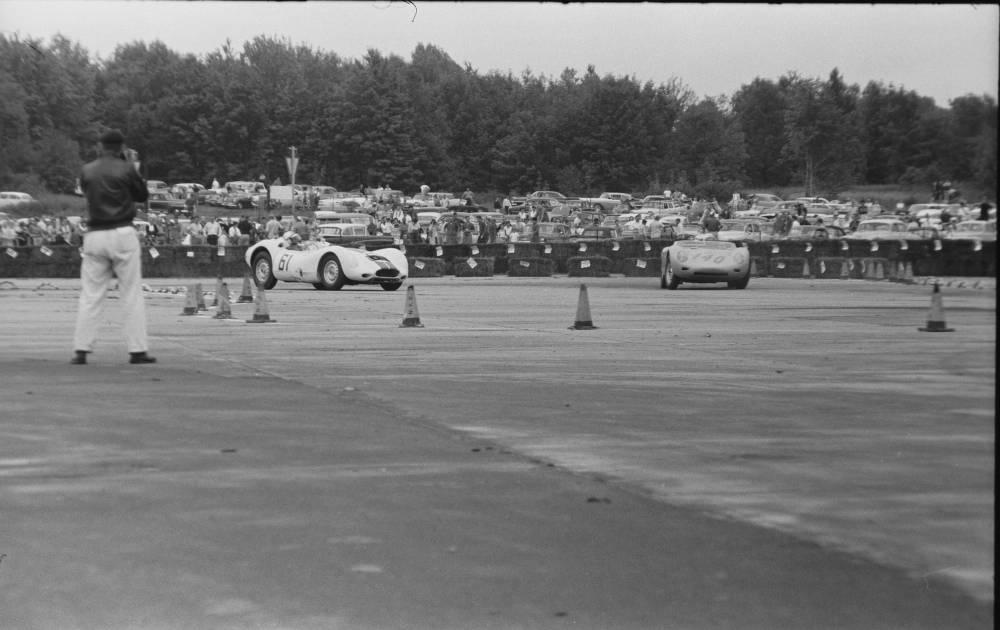 20239_pf0102_02_0003. Car races. Photo by Aaron Rennert, ca. 1957-1960. Photo-Sound Associates, Ron Cohen Collection (20239).
20239_pf0102_02_0003. Car races. Photo by Aaron Rennert, ca. 1957-1960. Photo-Sound Associates, Ron Cohen Collection (20239).
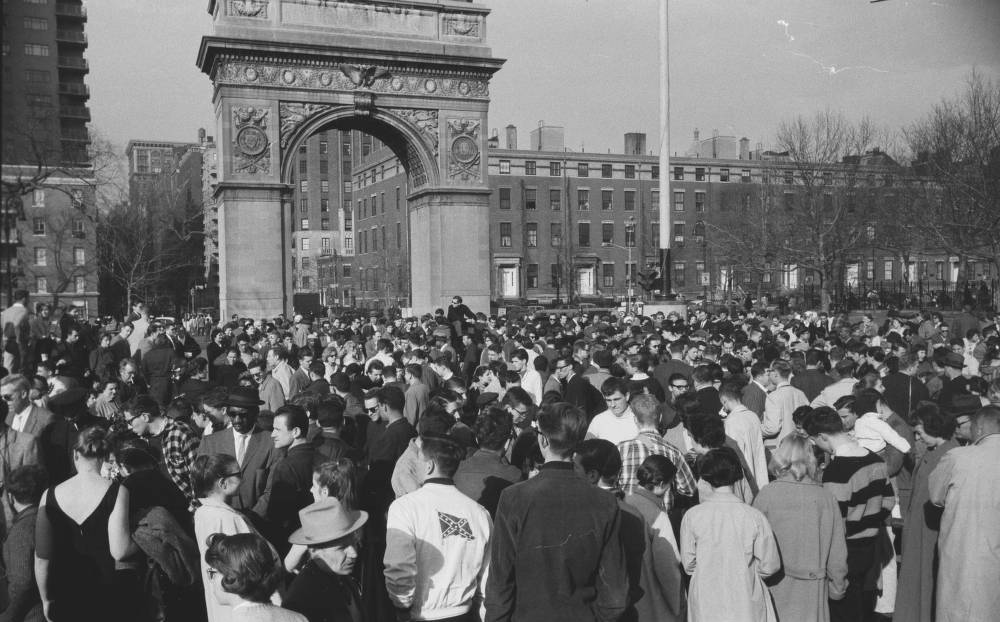 20239_pf0082_01_0006. Crowd in Washington Square Park, 5 May 1959. Photo by Aaron Rennert. Photo-Sound Associates, Ron Cohen Collection (20239).
20239_pf0082_01_0006. Crowd in Washington Square Park, 5 May 1959. Photo by Aaron Rennert. Photo-Sound Associates, Ron Cohen Collection (20239).
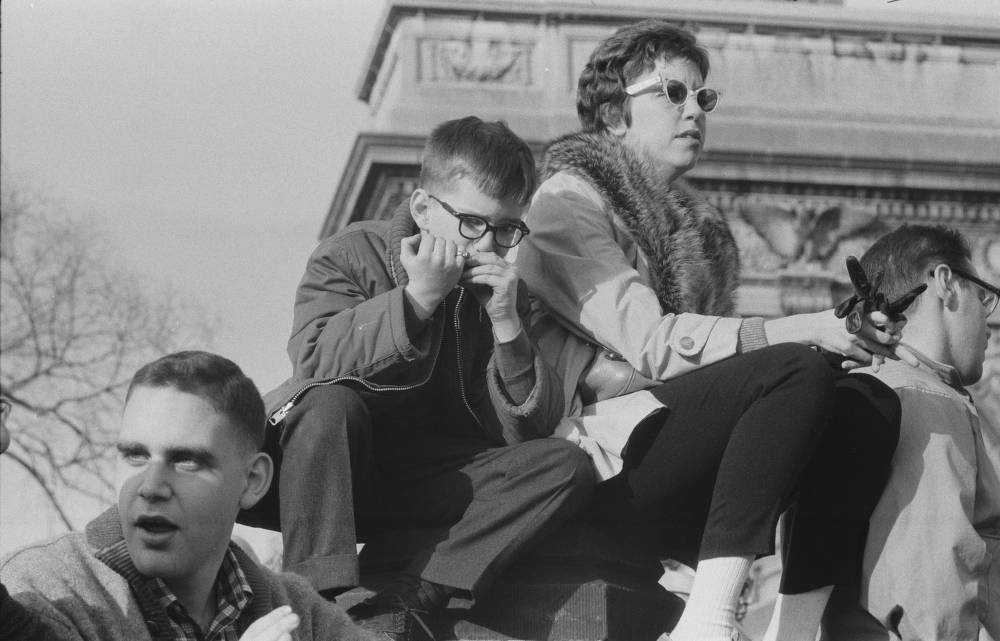 20239_pf0082_01_0010. Listeners, small boy playing harmonica, Washington Square Park, 5 May 1959. Photo by Aaron Rennert. Photo-Sound Associates, Ron Cohen Collection (20239).
20239_pf0082_01_0010. Listeners, small boy playing harmonica, Washington Square Park, 5 May 1959. Photo by Aaron Rennert. Photo-Sound Associates, Ron Cohen Collection (20239).
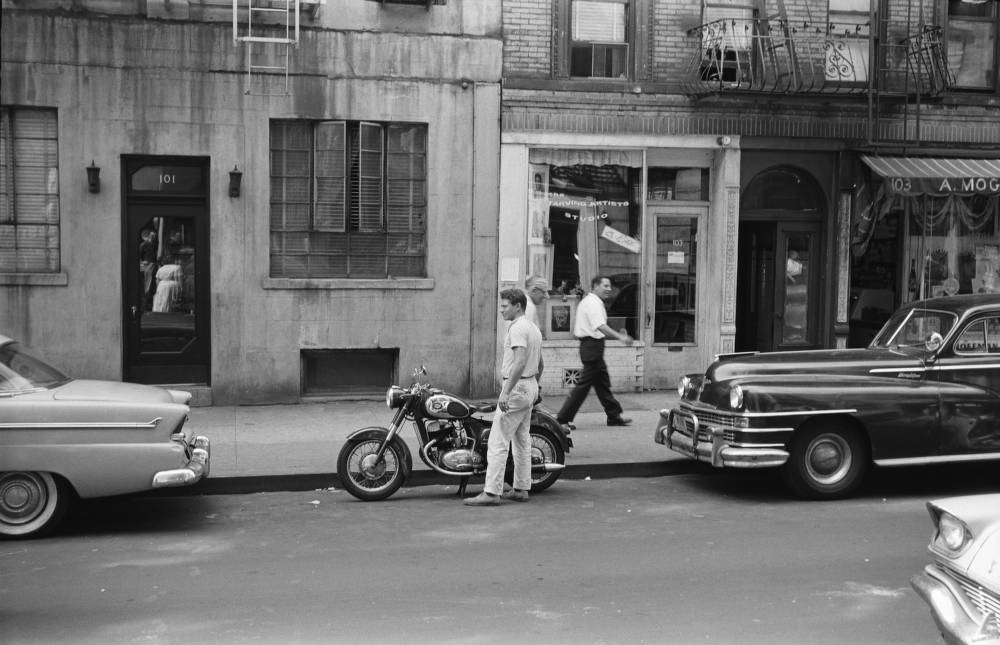 20239_pf0098_01_0013. Eric Weissberg and his Puch/Allstate 250cc two-stroke motorbike. Photo by “LH,” ca. 1957-1960. Photo-Sound Associates, Ron Cohen Collection (20239).
20239_pf0098_01_0013. Eric Weissberg and his Puch/Allstate 250cc two-stroke motorbike. Photo by “LH,” ca. 1957-1960. Photo-Sound Associates, Ron Cohen Collection (20239).
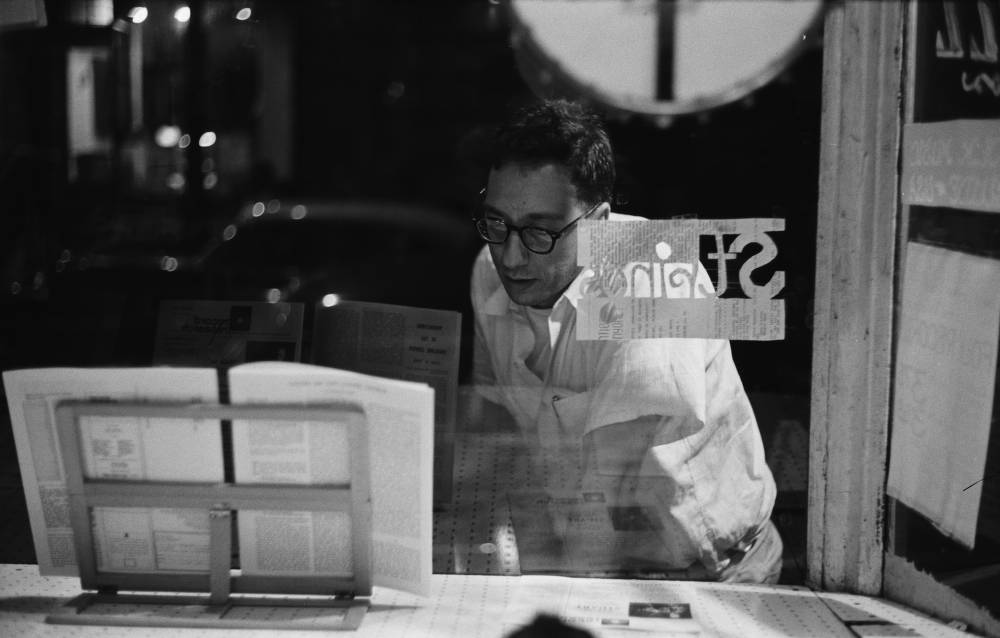 20239_pf0100_0015. Izzy Young looking in the Folklore Center, 27 July 1959. Photo by Aaron Rennert. Photo-Sound Associates, Ron Cohen Collection (20239).
20239_pf0100_0015. Izzy Young looking in the Folklore Center, 27 July 1959. Photo by Aaron Rennert. Photo-Sound Associates, Ron Cohen Collection (20239).
Tired Cat.Photo by “LH,” ca. 1957-1960. Photo-Sound Associates, Ron Cohen Collection (20239).
Southern Folklife Collection Flamenco photo of the week

Stunning photographs made by Aaron Rennert for Photo-Sound Associates, from the Ron Cohen Collection (20239). Shot in New York City, in the late 1950s, the images document a party attended by members of the famed Ballet Español de Ximenez-Vargas. Dancers include (from top to bottom): Carmen Rivas, an unidentified man, Maria Alba (Flamenco dance star who studied with Mariquita Flores and by 1957 or so was dancing with Ximenez-Vargas), and Antonio Hector de Jesus.
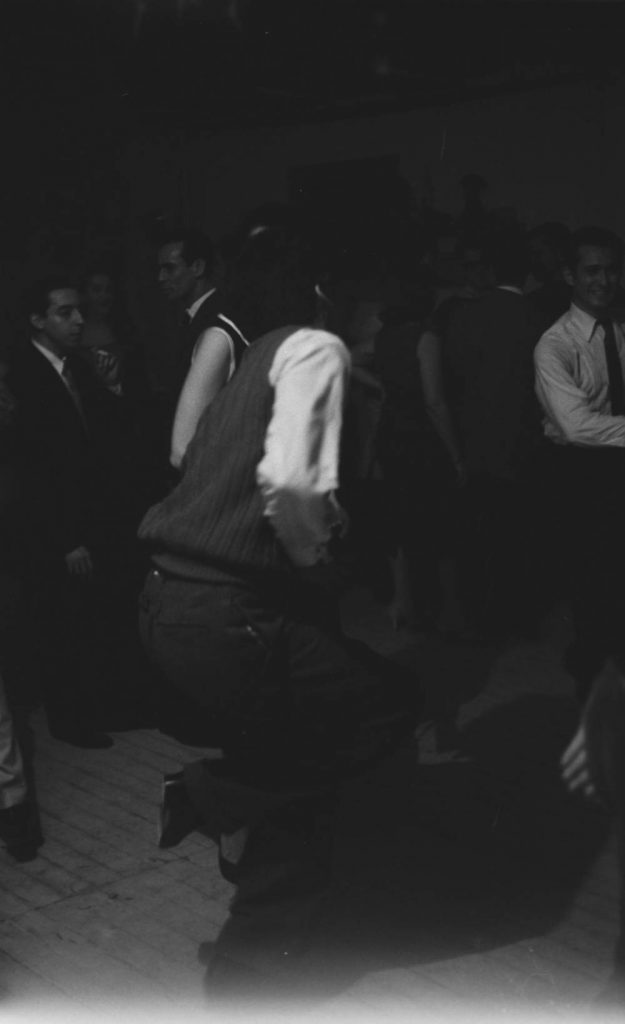

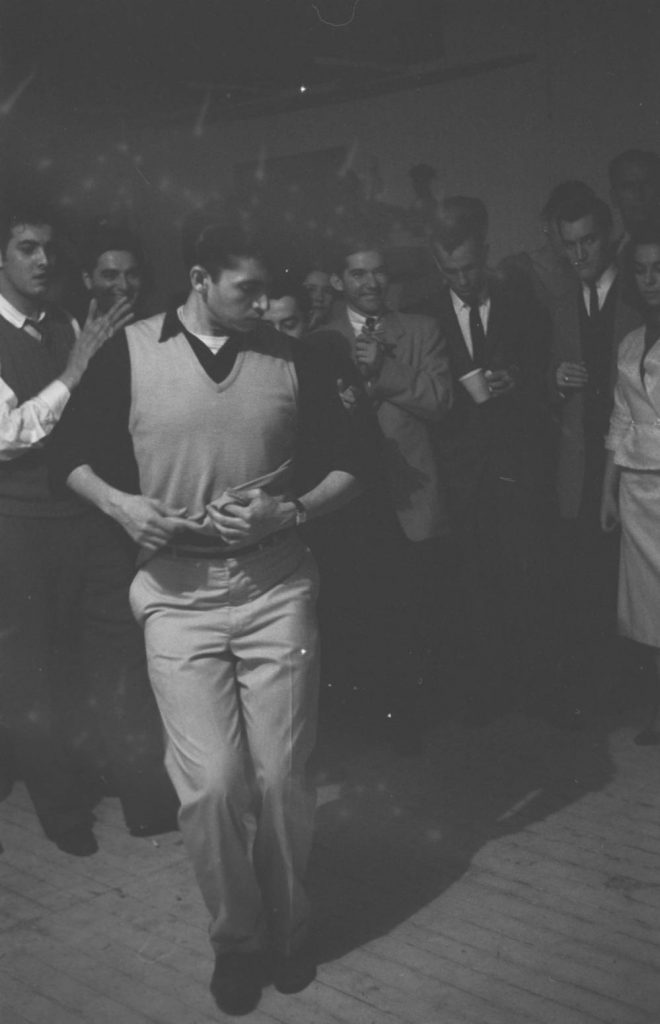
Lard Have Mercy! 30 Years of Southern Culture on the Skids
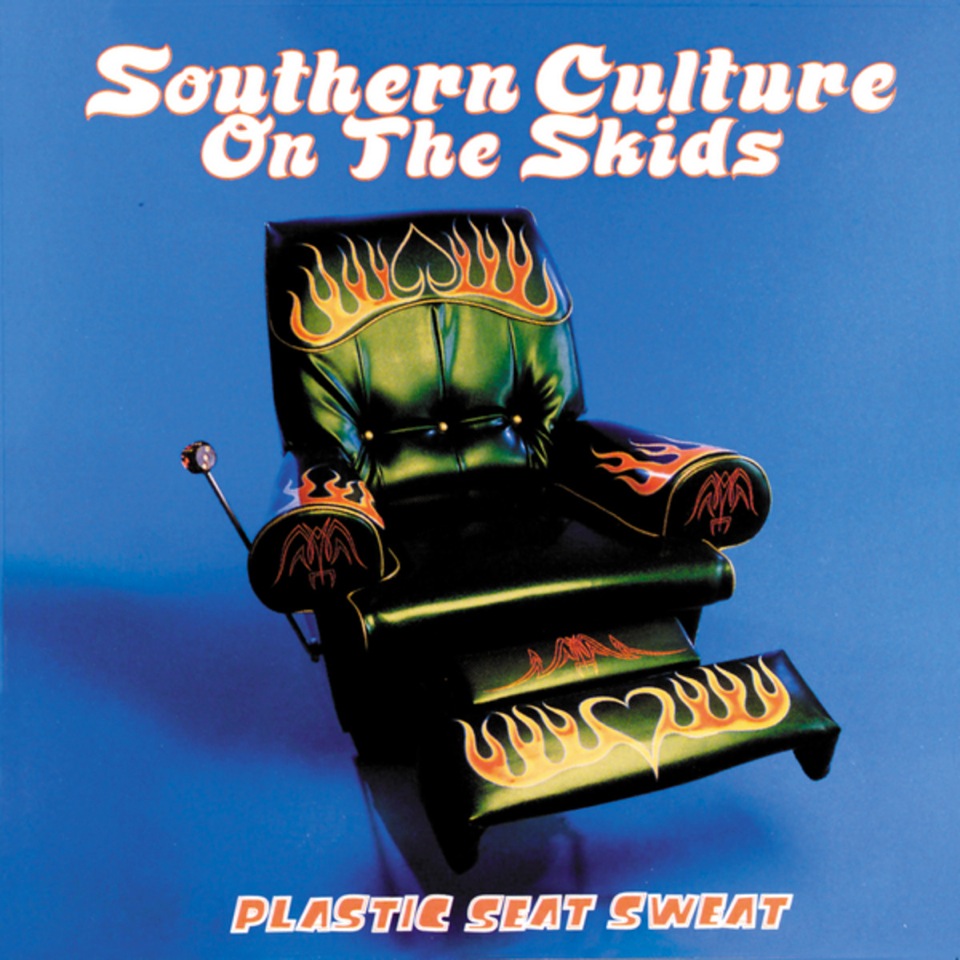 The Southern Folklife Collection is pleased to announce our first exhibit and program of 2014, “Lard Have Mercy! 30 Years of Southern Culture on the Skids.” The exhibit opens Friday, March 14, 2014 at 6PM on the 4th floor of the Wilson Library at UNC-Chapel Hill. The exhibit opening will be followed by a concert at Historic Playmakers Theater featuring none other than Southern Culture on the Skids. Both events occur in conjunction with the annual conference of the International Association for the Study of Popular Music (IASPM) taking place March 13-16 at UNC-Chapel Hill.
The Southern Folklife Collection is pleased to announce our first exhibit and program of 2014, “Lard Have Mercy! 30 Years of Southern Culture on the Skids.” The exhibit opens Friday, March 14, 2014 at 6PM on the 4th floor of the Wilson Library at UNC-Chapel Hill. The exhibit opening will be followed by a concert at Historic Playmakers Theater featuring none other than Southern Culture on the Skids. Both events occur in conjunction with the annual conference of the International Association for the Study of Popular Music (IASPM) taking place March 13-16 at UNC-Chapel Hill.
“Lard Have Mercy” traces the history of Chapel Hill’s “Legendary Bards of Downward Mobility,” Southern Culture on the Skids (SCOTS). Formed in 1983. SCOTS embody a raucous, sleazy, good-natured, good-time take on Southern traditions and traditional music playing a unique hybrid of Americana, surf, R&B, rockabilly, and swamp pop, driving fans into ecstatic, sweat-drenched paroxysms of joy.
Featuring photography by Kent Thompson and Michael Benson as well as instruments, posters, recordings, and other ephemera from the SCOTS collection in the Southern Folklife Collection.
Events are free and open to the public but seating is limited. Concert Tickets will be available via Memorial Hall Box Office (919) 843-3333 the week of March 3rd. More information about the concert below.
Ticket booth opens: 6pm
Doors: 7pm
Concert: 7:30pm
“A HELL RAISING ROCK AND ROLL PARTY” – ROLLING STONE

Noble Ray Price, the Cherokee Cowboy
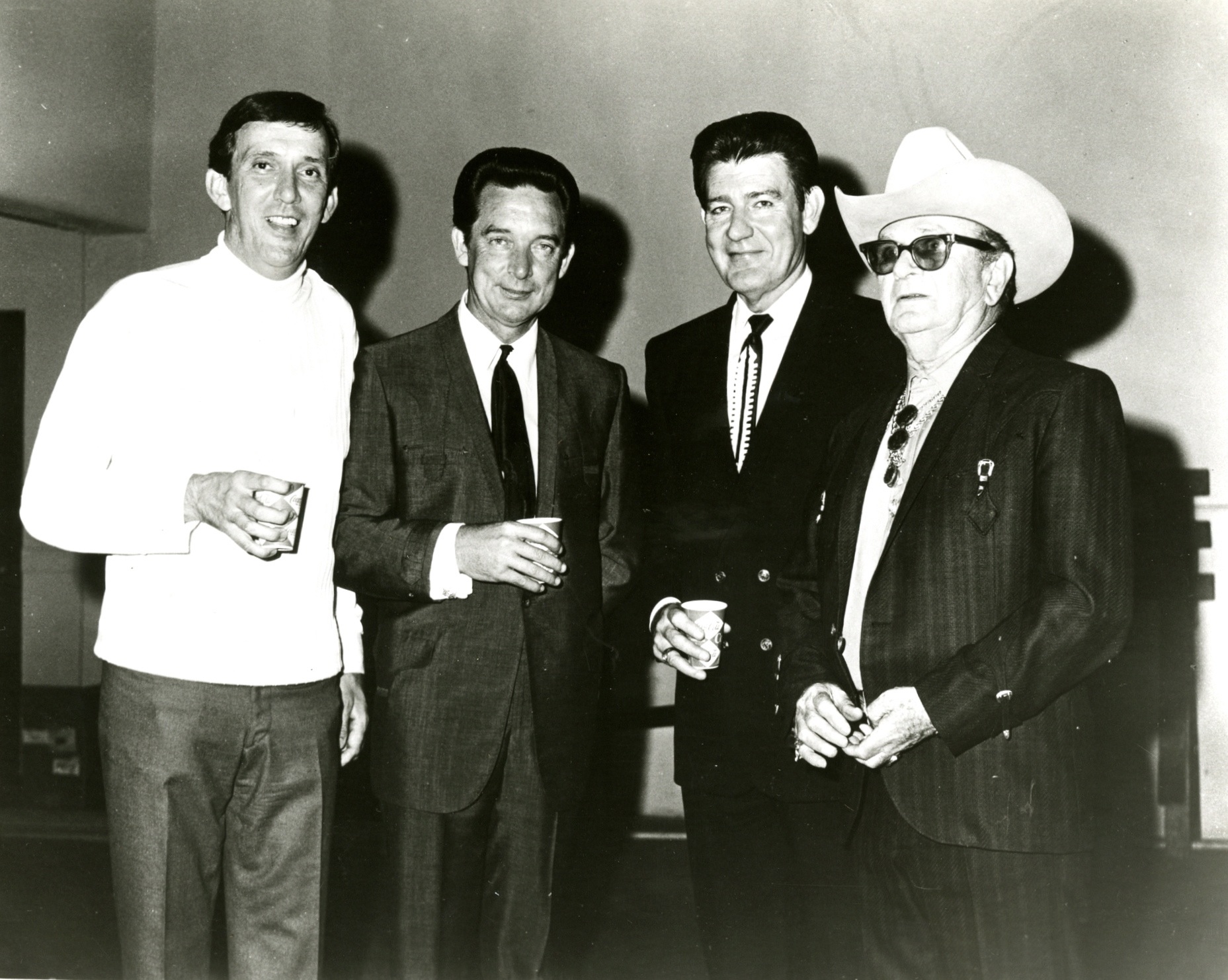 P3910. Standing from left to right: KBBQ disc jockey Hugh Jarrett, musicians Ray Price and Tex Williams, and tailor Nudie Cohn. The four are backstage at the KBBQ First Anniversary Show. Southern Folklife Collection Radio and Television Files (30015).
P3910. Standing from left to right: KBBQ disc jockey Hugh Jarrett, musicians Ray Price and Tex Williams, and tailor Nudie Cohn. The four are backstage at the KBBQ First Anniversary Show. Southern Folklife Collection Radio and Television Files (30015).
Country legend, Ray Price died this week at his home in Texas at the age of 87. The “Ray Price Shuffle,” a 4/4 beat developed by the Cherokee Cowboy himself remains a staple of the honky tonk sound. Combined with his velvet voice and countrypolitan ballads, Price changed the sound of Nashville. We picked out a few items from the Southern Folklife Collection to share in remembrance of Price and his lasting legacy. The photo above, P3910 from the Southern Folklife Collection Radio and Television Files (30015) features Price along with one of his great friends, fashion designer Nudie Cohn. Price could often be found on stage wearing one of Cohn’s “Nudie Suits.” Price’s visual style remained impeccable throughout his career, but it was always his voice that separated him from the rest of the crooners. Listen to his great rendition of the Harlan Howard tune, “Heartache by the Numbers” from call no. 45-1472. 45_1472_Heartache_by_the_numbers_Ray_Price_SFC
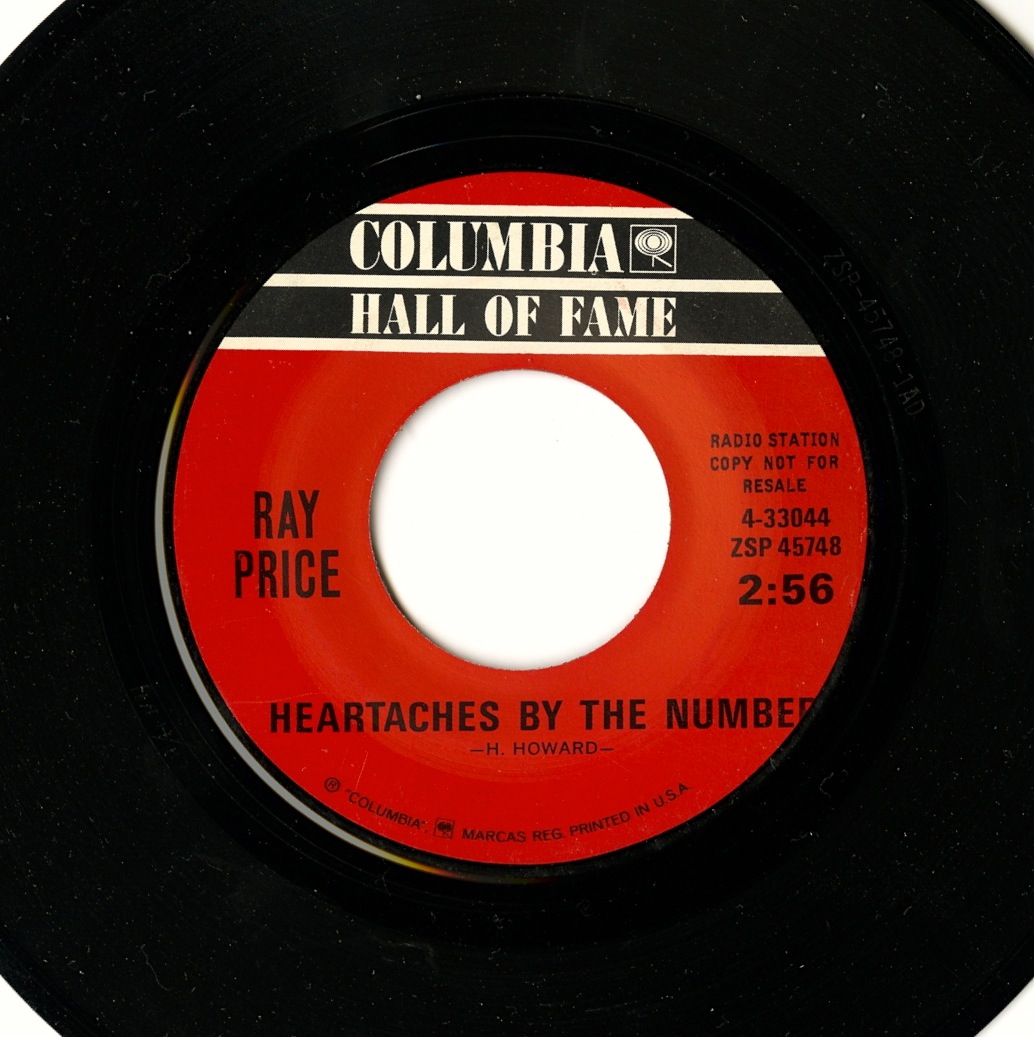 Another classic from Price’s massive catalog is his hit, “Take Me As I Am (or let me go). This Don Law produced single has the full “Nashville Sound,” a full orchestra and choral arrangement to back Price’s powerful voice and make the syrupy lyrics wonderfully bittersweet. We found a unique promotional flier for the song in the Southern Folklife Collection Artist Name Files (30005), NF1596. These items are but a blip in Price’s 65 year career. We’d love to show you more but you’ll have to make a visit to Wilson Library. For now, let’s sit back and enjoy one more song.45_1858_Take_me_as_I_am_Ray_Price_SFC
Another classic from Price’s massive catalog is his hit, “Take Me As I Am (or let me go). This Don Law produced single has the full “Nashville Sound,” a full orchestra and choral arrangement to back Price’s powerful voice and make the syrupy lyrics wonderfully bittersweet. We found a unique promotional flier for the song in the Southern Folklife Collection Artist Name Files (30005), NF1596. These items are but a blip in Price’s 65 year career. We’d love to show you more but you’ll have to make a visit to Wilson Library. For now, let’s sit back and enjoy one more song.45_1858_Take_me_as_I_am_Ray_Price_SFC

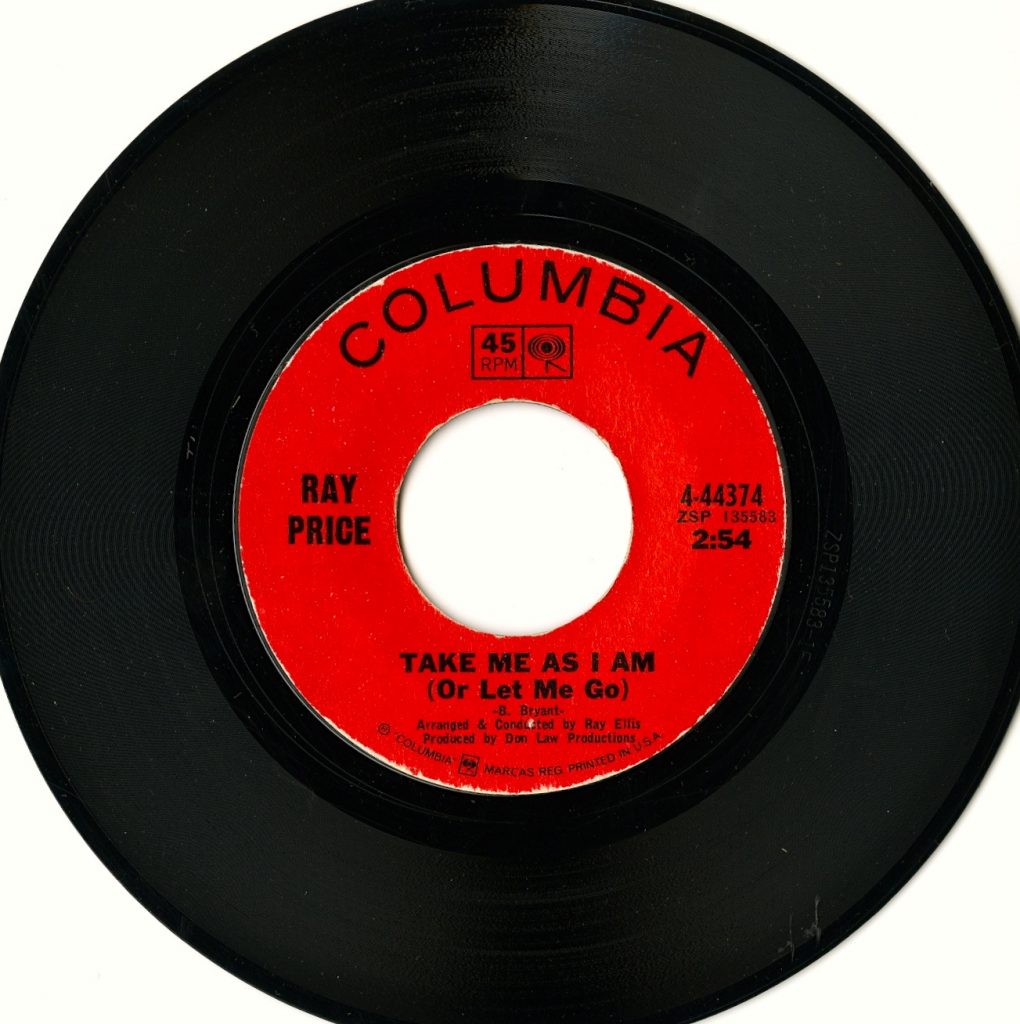
Goldband Records approved "Sweet Potato Mash"
Sweet potato patch in Cleveland County,
call no. P0072/0010, Commercial Museum Collection of North Carolina Photographs (P0072)
North Carolina Collection Photographic Archives.
Don’t forget your eat your sweet potatoes tomorrow. No matter whether you roast them, bake them, fry them, hasselback them, or cook them with marshmallows on top, the Southern Folklife Collection has your soundtrack covered thanks to a seasonally appropriate tape from the Goldband Recording Corporation Collection (20245) that came up in the Rivers Studio just this week.
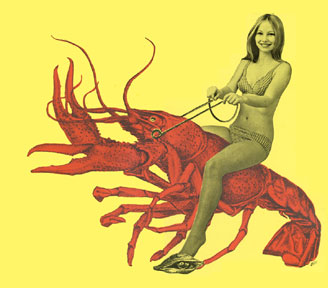
William Parker Guidry, Jr., came up in Southwest Louisiana and Lake Charles, performing and recording as Bill Parker for a number of labels, including Eddie Shuler’s Goldband Records. A drummer and bandleader, he appears all over the Goldband discography, and the man must have been a huge fan of the sweet potato because he wrote and recorded at least two tunes, including a cha-cha, dedicated to the noble tuber.
For you dear readers and listeners, we have “Sweet Potato Mash” by Bill Parker and his Showboat Band. FT7003 was digitized as part of the Southern Folklife Collection digitization project, From the Piedmont to the Swamplands: Preserving Southern Traditional Music, funded by a grant from the National Endowment for the Humanities.
FT7003_sweet potato 2_Goldband Recording Corporation Collection (20045)
Ham, corn and fiddle tunes at Tommy Jarrell's
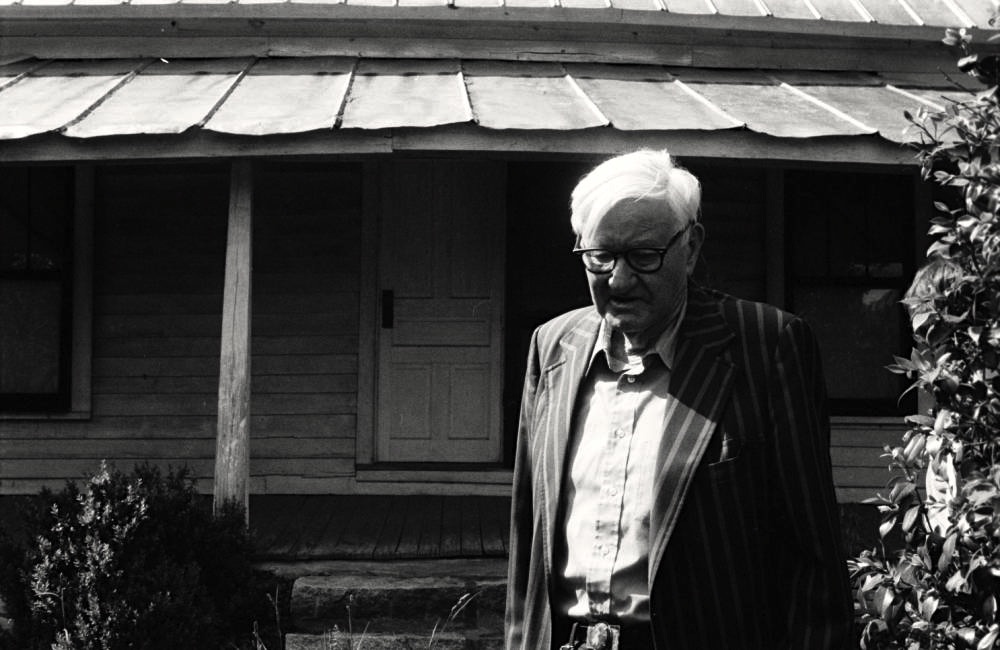 Back in 2009 we wrote about a field recording, call no. FS8341 from the Alice Gerrard Collection, documenting the Christmas she and Andy Cahan spent with Tommy Jarrell and his daughter Dena in 1983. For those who are interested, they had chicken and “it was so fine.”
Back in 2009 we wrote about a field recording, call no. FS8341 from the Alice Gerrard Collection, documenting the Christmas she and Andy Cahan spent with Tommy Jarrell and his daughter Dena in 1983. For those who are interested, they had chicken and “it was so fine.”
That’s not the only holiday recording in the Alice Gerrard Collection. FS8205 was made in 1981 when Alice and a few others, including old-time musician Rusty Neithammer, spent Thanksgiving with Tommy. They had ham, and also some corn, according to the tape.FS8205_Ham
How many other holiday menus and recipes were recorded in the process of doing field work that are now held in Wilson Library at UNC? These recordings and thousands more are available for research in the Southern Folklife Collection. There was quite a bit of music at that Thanksgiving celebration, listen to Jarrell’s solo banjo version of “Let Me Fall” and then Rusty Neithammer and Tommy Jarrell twin fiddle one of my favorites, “Rockingham Cindy.”FS8205_Let Me Fall_BanjoFS8205_Rockingham Cindy
The Southern Folklife Collection is thankful to be able to share this with all of you out there. Happy Thanksgiving.
SFC Spooky Spotlight: A "Mummie's Curse" uncovered in the Goldband Recording Corporation Collection
 With the Wilson Library live action Clue Game happening tonight and All Hallow’s Eve tomorrow, it’s no surprise that strange phenomena have been occuring in the Southern Folklife Collection studios. Just this morning, preservation audio engineer Brian Paulson digitized the Goldband Records master tape of Satan and the Deciples, call no. FT6891 in the Goldband Recording Corporation Collection (20245), as part of our current digitization project, From the Piedmont to the Swamplands: Preserving Southern Traditional Music.
With the Wilson Library live action Clue Game happening tonight and All Hallow’s Eve tomorrow, it’s no surprise that strange phenomena have been occuring in the Southern Folklife Collection studios. Just this morning, preservation audio engineer Brian Paulson digitized the Goldband Records master tape of Satan and the Deciples, call no. FT6891 in the Goldband Recording Corporation Collection (20245), as part of our current digitization project, From the Piedmont to the Swamplands: Preserving Southern Traditional Music.
 Brian arrived to work this morning, having left the Rivers Studio in proper order when he left last night, to find this open reel tape spooled on the Otari ready for playback. No one knows how the tape got from the stacks to the studio or what could have loaded the tape onto the machine. Not one to question the will and ways of the supernatural, of course Brian played the tape, reavealing the following horrifying song, “Mummie’s Curse.”FT6891_ Satan and Deciples_Mummie’s Curse_Goldband Recording Corporation Collection (20245)_Southern Folklife CollectionNot much is known about Satan and the Deciples (aka Satan and Satin’s Roses, aka Satin and the Deciples). The theory we agreed upon in the Rivers Studio accepts that the band rose out of the swamps around Lake Charles, called from eternal slumber to terrorize the honky-tonks of East Texas like so many of the undead. Other more likely theories suggest the band was a novelty project made up of a crew of local bar band musicians that liked scary movies. Considering the Deciples featured one Baldemar Huerta (aka Freddy Fender who co-wrote both tracks on this tape) on lead guitar, the latter theory is more plausible. We may never know the truth, but we were inspired to pull out Jason Lonon’s poster for a “Halloween Ho-down” (featured above) to share with you fine readers, call no. OP-20451/16 from the Jason Lonon Poster Collection (20451).
Brian arrived to work this morning, having left the Rivers Studio in proper order when he left last night, to find this open reel tape spooled on the Otari ready for playback. No one knows how the tape got from the stacks to the studio or what could have loaded the tape onto the machine. Not one to question the will and ways of the supernatural, of course Brian played the tape, reavealing the following horrifying song, “Mummie’s Curse.”FT6891_ Satan and Deciples_Mummie’s Curse_Goldband Recording Corporation Collection (20245)_Southern Folklife CollectionNot much is known about Satan and the Deciples (aka Satan and Satin’s Roses, aka Satin and the Deciples). The theory we agreed upon in the Rivers Studio accepts that the band rose out of the swamps around Lake Charles, called from eternal slumber to terrorize the honky-tonks of East Texas like so many of the undead. Other more likely theories suggest the band was a novelty project made up of a crew of local bar band musicians that liked scary movies. Considering the Deciples featured one Baldemar Huerta (aka Freddy Fender who co-wrote both tracks on this tape) on lead guitar, the latter theory is more plausible. We may never know the truth, but we were inspired to pull out Jason Lonon’s poster for a “Halloween Ho-down” (featured above) to share with you fine readers, call no. OP-20451/16 from the Jason Lonon Poster Collection (20451).
Happy Halloween.
"Saving Our Heritage for the Next Generation": 7th World Day for Audiovisual Heritage
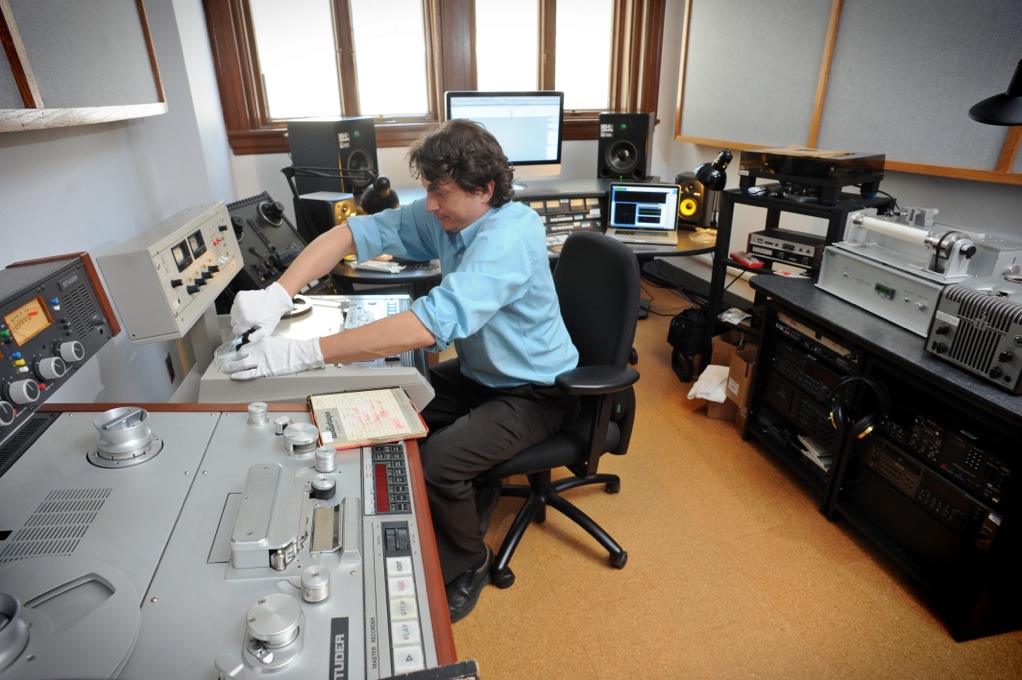 UNESCO, in cooperation with the Co-ordinating Council of Audiovisual Archives Associations (CCAAA) and other partners, has adopted 27 October as the World Day for Audiovisual Heritage to better focus global attention on the significance of AV documents and to draw attention to the need to safeguard them. The theme for this year’s celebration is “Saving Our Heritage for the Next Generation.”
UNESCO, in cooperation with the Co-ordinating Council of Audiovisual Archives Associations (CCAAA) and other partners, has adopted 27 October as the World Day for Audiovisual Heritage to better focus global attention on the significance of AV documents and to draw attention to the need to safeguard them. The theme for this year’s celebration is “Saving Our Heritage for the Next Generation.”
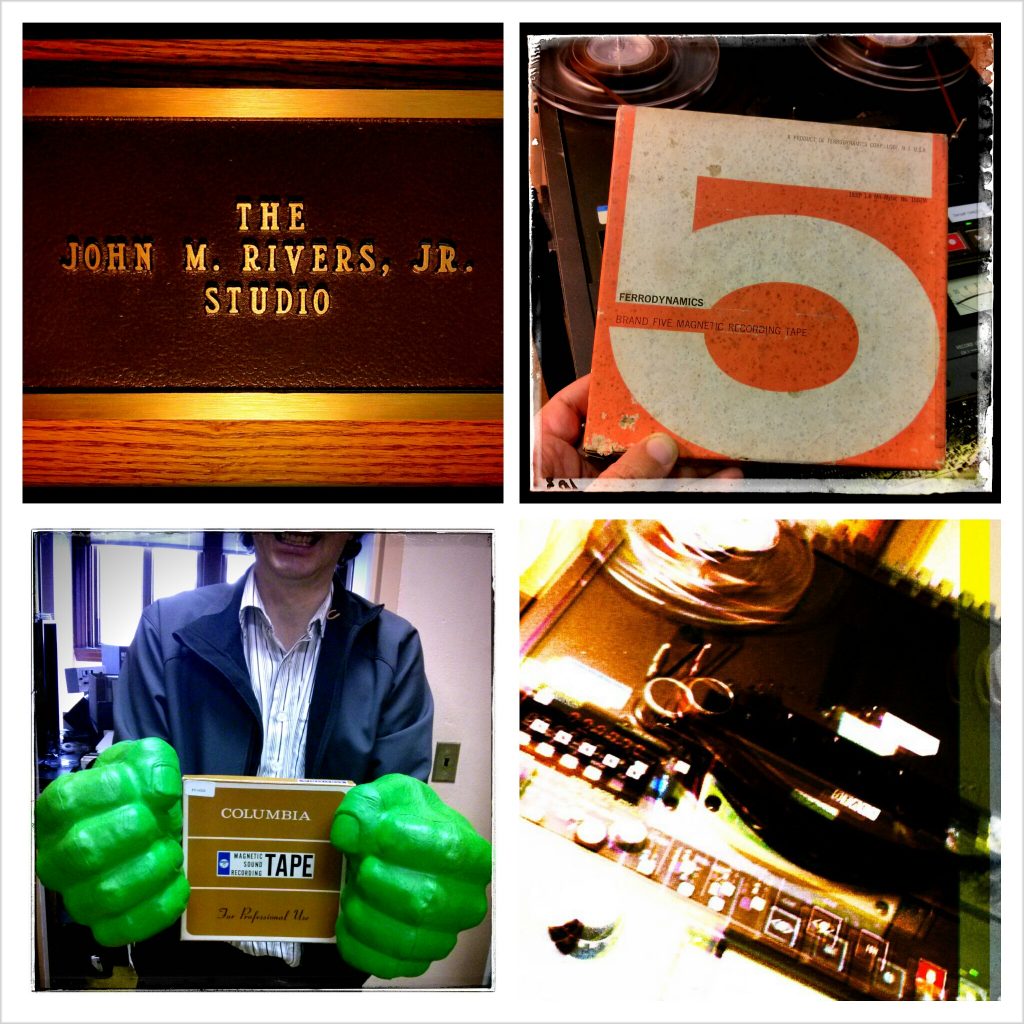 The Southern Folklife Collection works toward this goal daily in our efforts to preserve the hundreds of thousands of sound recordings, film and video housed in Wilson Library. Through grant-funded digitization projects and through research driven requests, the Southern Folklife Collection has digitized and made available tens of thousands of recordings documenting the vast riches of traditional expressive culture from the American South and around the world. The John M. Rivers, Jr. Studio (pictured above, right, and below) and the Ben Jones Audio and Video Studios constantly echo with the sounds, songs, and stories collected from centuries past through the 21st.
The Southern Folklife Collection works toward this goal daily in our efforts to preserve the hundreds of thousands of sound recordings, film and video housed in Wilson Library. Through grant-funded digitization projects and through research driven requests, the Southern Folklife Collection has digitized and made available tens of thousands of recordings documenting the vast riches of traditional expressive culture from the American South and around the world. The John M. Rivers, Jr. Studio (pictured above, right, and below) and the Ben Jones Audio and Video Studios constantly echo with the sounds, songs, and stories collected from centuries past through the 21st.
From the UNESCO statement:
Audiovisual documents, such as films, radio and television programmes, are our common heritage and contain the primary records of the 20th and 21st centuries. They help to maintain the cultural identity of a people; but countless documentary treasures have disappeared since the invention of image and sound technologies that permit the peoples of the world to better share their experiences, creativity and knowledge.
All of the world’s audiovisual heritage is endangered. Nowhere can it be said to be preserved, but through initiatives such as theWorld Day for Audiovisual Heritage and the Memory of the World Programme, the precious work of preservation professionals is given impetus to manage a range of technical, political, social, financial and other factors that threaten the safeguarding of our heritage.
It was in this context, that the General Conference in 2005 approved the commemoration of a World Day for Audiovisual Heritage as a mechanism to raise general awareness of the need for urgent measures to be taken and to acknowledge the importance of audiovisual documents as an integral part of national identity. (UNESCO)
In honor of the 7th World Day for Audiovisual Heritage, we wanted to highlight some of the recordings recently digitized as part of one of our current projects, From the Piedmont to the Swamplands: Preserving Southern Traditional Music, funded in part by the National Endowment for the Humanities. The multi-year effort will preserve and make accessible online up to 3,019 hours of sound recordings and 4,500 related photographs dating from the 1920s to 1980s, drawn from the Southern Folklife Collection holdings in the William R. Ferris Collection (20367), Mike Seeger Collection (20009), John Edwards Memorial Foundation Records (20001), and the Goldband Recording Corporation Collection (20245).
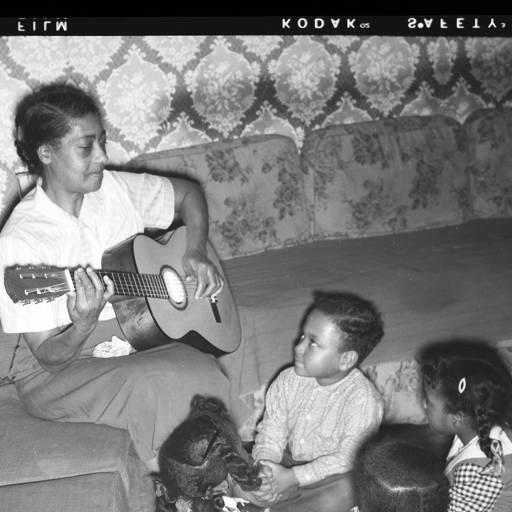 Regular readers of Field Trip South will not be surprised to see the Mike Seeger Collection featured here. Many of Seeger’s photographs are currently digitized and available for viewing online: iconic images of America’s musical treasures like Ralph and Carter Stanley, the Carter Sisters, Lesley Riddle, Dock Boggs, and of course, the beloved NC Piedmont picker and singer, Elizabeth Cotten.
Regular readers of Field Trip South will not be surprised to see the Mike Seeger Collection featured here. Many of Seeger’s photographs are currently digitized and available for viewing online: iconic images of America’s musical treasures like Ralph and Carter Stanley, the Carter Sisters, Lesley Riddle, Dock Boggs, and of course, the beloved NC Piedmont picker and singer, Elizabeth Cotten.
The Southern Folklife Collection has preserved hundreds of hours of Seeger’s field recordings and his own master tapes. Every tape is a treat, but occasionally we come upon an especially outstanding track like this version of “Well May the World Go” featuring Mike performing with his brother, the legendary folksinger Pete, on 29 January 1973. They tore through three versions of the tune that day. Have a listen to the third take of that piece here, from FT14925 in the Mike Seeger Collection:FT14295_Mike_Seeger_&_Pete_Seeger
Another recent standout track comes from The New Tranquility String Band (FT14198.) This outtake of “Boatman” was recorded during sessions for the Berkley Farms: Oldtime and Country Style Music of Berkley LP originally released for Smithsonian Folkways in 1972. This version version has the jaw harp higher in the mix, giving it a striking old-time feel that we like. FT14198_Mike_Seeger_Berkley
 The Piedmont to the Swamplands grant also allowed us to digitize the majority of audio recordings collected by folklorist and UNC professor William R. Ferris. With thousands of audio recordings, photographs, and feet of film, the William R. Ferris Collection is an invaluable resource documenting the people and culture of the American South, an archival treasure trove reflecting the ineffable “sense of place” that makes the South such a compelling–and haunting–place. Many of Ferris’s photographs are available online. This performance by a young child, Don Singleton recorded on FT 9918, made our jaws drop.
The Piedmont to the Swamplands grant also allowed us to digitize the majority of audio recordings collected by folklorist and UNC professor William R. Ferris. With thousands of audio recordings, photographs, and feet of film, the William R. Ferris Collection is an invaluable resource documenting the people and culture of the American South, an archival treasure trove reflecting the ineffable “sense of place” that makes the South such a compelling–and haunting–place. Many of Ferris’s photographs are available online. This performance by a young child, Don Singleton recorded on FT 9918, made our jaws drop.
FT9918_BFC_FANNIE BELL CHILDRENS CONCERT
This next tape was recorded during the process of filming a documentary film about the remarkable Fannie Bell Chapman. The complete film can be viewed in full on Folkstreams.net., Fannie Bell Chapman: Gospel Singer. The following version of “Now Sister Go Where I Send Thee” is from FT9974, the first of six tapes recording Chapman’s music recorded in August 1975. FT9974_BFC_Fannie Bell Chapman_Now Sister Go Where I Send Thee
 Ferris documented the secular as well as the sacred and his recordings of Mississippi blues artists are equally vital documents. The following track is from one of the first recordings of the bluesman “Big Jack” Johnson. From FT11151, this is Johnson performing on guitar with harmonica player Wash Herron. FT11151_BFC_Wash Herron_Big Jack_Johnson
Ferris documented the secular as well as the sacred and his recordings of Mississippi blues artists are equally vital documents. The following track is from one of the first recordings of the bluesman “Big Jack” Johnson. From FT11151, this is Johnson performing on guitar with harmonica player Wash Herron. FT11151_BFC_Wash Herron_Big Jack_Johnson
These clips offer but a glimpse into the Southern Folklife Collection’s preservation efforts. The public is encouraged to explore our finding aids for detailed inventories and description of archival collections and the UNC Libraries online catalog for materials of interest and request that they be preserved and made available for research. Feel free to contact the SFC with any comments or questions at wilsonlibrary@unc.edu. We also hope you will enjoy some music this Sunday, October 27, World Day for Audiovisual Heritage, and think about institutions like the Southern Folklife Collection, the Library of Congress, and countless other archives and institutions that are working to preserve our aural and visual history. 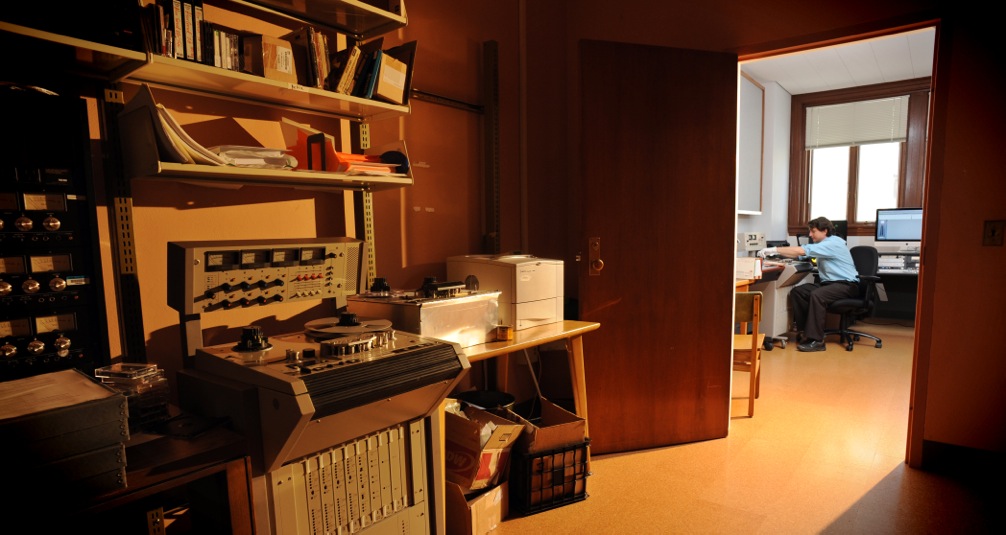
Domo Arigato Mike Seeger and Alice Gerrard
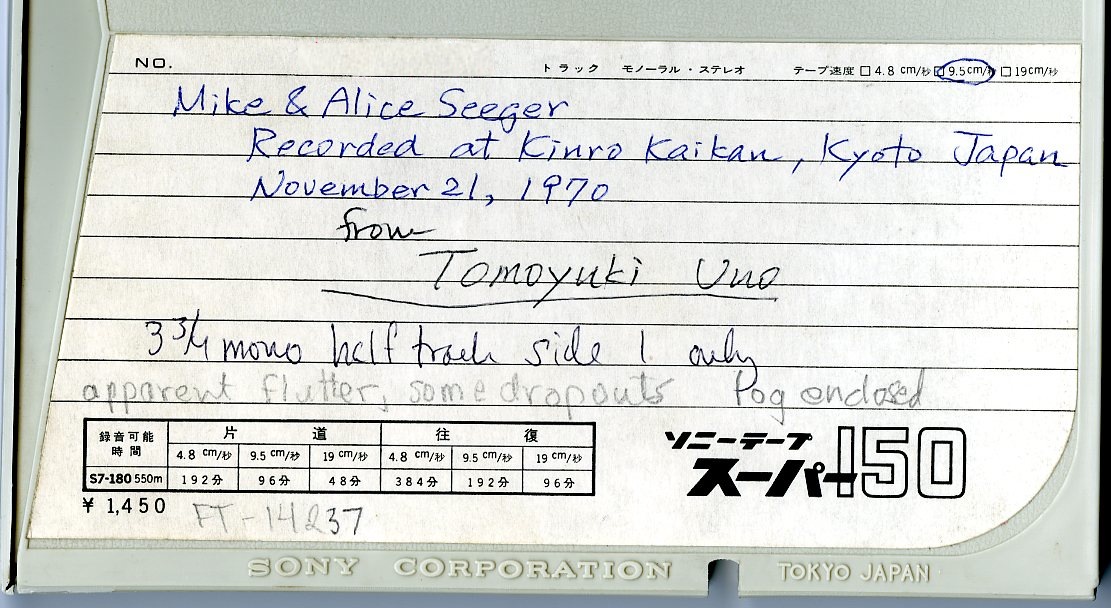
Two tapes from the Mike Seeger Collection (20009) preserved as part of the Southern Folklife Collection’s ongoing project “From Piedmont to Swamplands,” supported by the National Endowment of the Humanities, recently caught the attention of audio engineer John Loy. The first, call number FT14237, features an interview/performance by Mike Seeger and Alice Gerrard on November 21, 1970 at the Kinro Kaikan in Kyoto Japan. It contains 90 minute concert and interview with commentary in Japanese. The program intended provide Japanese listeners with an introductory survey of American old time and vernacular music styles. A wonderful document of cultural exchange.
Blog MS 1_LC
Blog MS 2_LC
Another recent find is a tape master sent to Mike in 1969 by the ‘Styx River Ferry ‘ a prominent “Hippy Country” group in the San Francisco/Berkeley area. This band features a who’s who of Bay area bluegrass fixtures rounded up by Bob and Ingrid Fowler. For this recording, call number FT14220, the group enlisted the help of legends of the day with guest performances by “Uncle Josh” Graves and “Cousin Jake” Tullock of the Foggy Mountain Boys. Of particular interest to us is the contextual information on the label, not only including song titles and band members, but also the recording studio, production personnel and a short list of bay area local venues at which the group was performing at the time. Catching Styx River Ferry at the Drinking Gourd would have been quite a time. Listen:Blog MS 3_LC
Blog MS 4_LC
